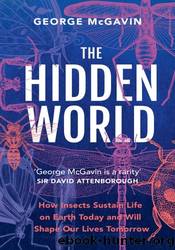The Hidden World by George McGavin

Author:George McGavin [McGavin, George]
Language: eng
Format: epub
ISBN: 9781802794953
Published: 0101-01-01T00:00:00+00:00
Chapter 6
THE AFTERLIFE
The great recycling plant
I have always enjoyed walking along beaches looking for things that have been left behind by the receding tide. Once, as a teenager, I found a dead gannet on the strand line of the beach at Brora in north east of Scotland. I had never seen such a large bird up close. I picked it up, holding the wings out to the side. The smell was absolutely dreadful and, as I laid the bird down on its back, I could see that most of the underside had been eaten away by maggots. Some of them had fallen onto the pebbles and were wriggling out of sight. The head of the gannet looked intact and I wanted to keep the skull. I set about finding a tin can large enough to take the head and enough dry wood from the upper shore to make a small fire. Soon my gannet head was bobbing up and down in boiling sea water and later, I was able to take the cleaned skull home for further examination.
The inside surfaces of the upper and lower bill sheath were armed with hundreds of tiny, backward-pointing teeth. I ran my finger along the bill from front to back, and the surfaces seemed smooth, but doing it the other way was quite impossible. The sharp teeth tugged and pulled at my flesh. It was not difficult to understand how this would be a great boon for the bird. A fish seized by a diving gannet would slide easily between the birdâs jaws but would not fall out before the gannet surfaced to swallow it. A gannet is well adapted for the job of catching fish. It is a superbly streamlined bird with no external nostrils, and air sacs on the face and chest to cushion it from the impact of diving vertically from a height of 30 metres at speeds of around 100 kilometres per hour.
But I had completely missed the bigger picture. No less well adapted were the hundreds of maggots that had been busily reanimating the dead gannet on the beach â transforming it in the space of a couple of weeks from one kind of flying creature into a different kind of flying creature altogether â many hundreds of them.
This chapter reflects that life on Earth depends on death and decomposition. Living things are made from the remains of dead things. There is a fixed amount of matter in the biosphere, so it follows that it must be used over and over again. Our bodies are made up largely of six elements, of which oxygen, carbon and hydrogen make up 92%. Every single atom that makes up you and me has been used before. The great British polymath Jacob Bronowski said, âYou will die but the carbon will not â its career does not end with you. It will return to the soil, and there a plant may take it up again in time, sending it once more on a cycle of plant and animal life.
Download
This site does not store any files on its server. We only index and link to content provided by other sites. Please contact the content providers to delete copyright contents if any and email us, we'll remove relevant links or contents immediately.
Sapiens: A Brief History of Humankind by Yuval Noah Harari(13084)
The Tidewater Tales by John Barth(12040)
Do No Harm Stories of Life, Death and Brain Surgery by Henry Marsh(6343)
Mastermind: How to Think Like Sherlock Holmes by Maria Konnikova(6257)
The Thirst by Nesbo Jo(5800)
Why We Sleep: Unlocking the Power of Sleep and Dreams by Matthew Walker(5664)
Sapiens by Yuval Noah Harari(4558)
Life 3.0: Being Human in the Age of Artificial Intelligence by Tegmark Max(4523)
The Longevity Diet by Valter Longo(4456)
The Rules Do Not Apply by Ariel Levy(3915)
The Immortal Life of Henrietta Lacks by Rebecca Skloot(3834)
The Body: A Guide for Occupants by Bill Bryson(3822)
Why We Sleep by Matthew Walker(3782)
Animal Frequency by Melissa Alvarez(3764)
Yoga Anatomy by Kaminoff Leslie(3713)
Barron's AP Biology by Goldberg M.S. Deborah T(3638)
The Hacking of the American Mind by Robert H. Lustig(3590)
All Creatures Great and Small by James Herriot(3528)
Yoga Anatomy by Leslie Kaminoff & Amy Matthews(3408)
